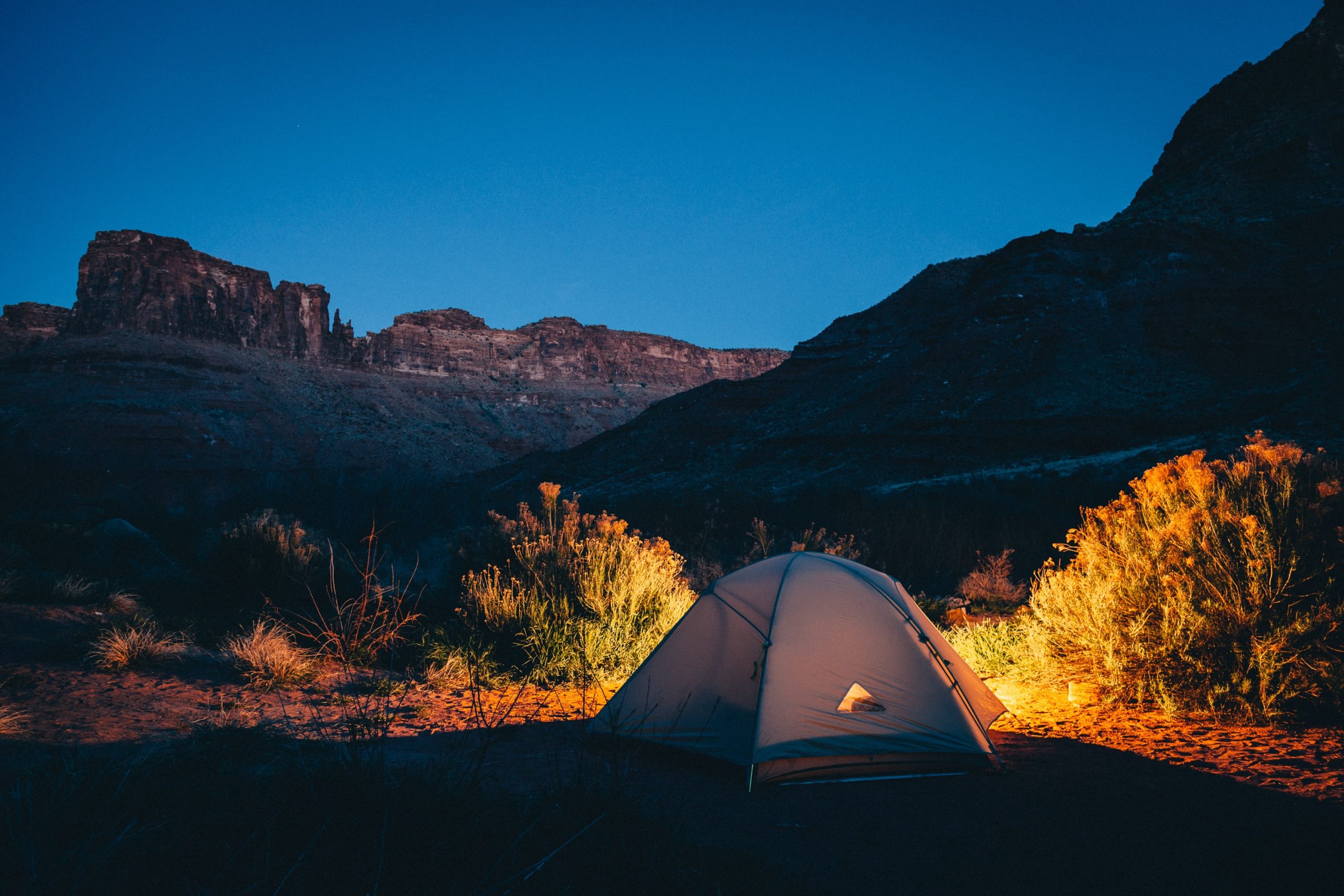
If you’ve been getting FOMO seeing your friends’ camping trips on Instagram, but you’re not sure where to start with planning one of your own—you’re not alone. Tent camping can feel a little intimidating, especially when it’s your first time.
To help you plan and prepare, I’ve rounded up 10 things you should know before taking your first tent camping trip, below. With these tips you’ll take your camping game from backyard to backpacking in no time.
1. Start with the basics of camping gear
At a bare minimum, you’ll need a tent and sleeping bag for shelter and warmth. However, keep in mind that not all tents and sleeping bags are created equal. Consider your tent size (depending on how many people are sharing your tent) along with its weight—especially if you’re backpacking where every pound counts.
Also, choose a sleeping bag that fits your seasonal needs. If you’re camping in the hot summer months, for example, you’ll want a lightweight sleeping bag versus the heavy duty one you’d take for a late fall trip when the temps are likely to dip at night.
If you’re not keen on sleeping on the ground, plan to also bring a sleeping pad and camp pillow to up the comfort factor. If you’re not backpacking, you could even consider a blow-up mattress.
As it pertains to safety, always bring a first-aid kit to handle anything from minor scrapes to injuries that require antibiotics. Be sure to also bring a map (hint: digital ones are great, but you'll never have to worry about losing cell service with a paper one). As for a digital map, there are several navigation apps that operate without Wi-Fi, like AllTrails or Guthook Guides. Just make sure to download the appropriate maps before you lose service. And come prepared with a back-up paper map in case your phone dies or gets damaged. Pack your map in an extra-large Ziploc bag to protect it from the rain (more rainy weather tips, below).
And always remember to bring a light source—preferably a headlamp so you’re hands free—that you can store and easily access during your trip (i.e., not at the bottom of your backpack!). I prefer to store my headlamp in the tent pocket closest to my pillow, so I always know where it is—and can easily find it in the dark.
2. You can rent, borrow, or buy second-hand gear
Since you’re new to camping, and maybe also testing the water with activities like kayaking or canoeing, you don’t have to go all-in with buying new gear. Instead, perform a quick Google search to reveal which outdoor retailer rents gear near you. You can also ask your outdoors-loving friend to borrow something of theirs. Or, head to a neighborhood yard sale or online marketplace to take a gently-used tent or kayak off of someone’s hands.
Doing so is better for the environment—and you don’t have to feel guilty if you’re not able to get away as often as you’d like (or end up re-selling said gear if camping winds up not being for you).
Read more: 8 Tips for a Sustainable Car Camping Trip
3. Practice pitching a new tent before your trip
If you do pick up or borrow a new-to-you tent, be sure to practice pitching it at home before your trip. The last thing you want to deal with on your first tent camping trip is pitching a tent in the dark—or in the rain!—without already knowing how the pieces fit together.
4. Reservations may be required, so book early
Since opting outside became all the rage (thanks, COVID), national parks and campgrounds have seen record bookings. If you’re planning a trip, be sure to check if a booking is necessary for your activities, and book what’s needed (e.g., campsite reservations, entry permits, fishing licenses, and so on) well in advance to avoid disappointment.
Tip: Once you’ve booked, forward your campground reservations and/or other bookings to TripIt to create a seamless itinerary with all of your trip details. You can also share these plans with family or friends so they know where you’ll be, even if you’re off the grid.
5. Prepare for inclement weather
No one wants to see rain in the forecast for their tent camping trip—I get it. But, being prepared can help mitigate (dare I say, chase away?) the chance of storm clouds rolling in and ruining your trip.
To start, lay a tarp down before you set up your tent. This will help create a barrier between your tent and the ground—and prevent moisture from seeping in. Be sure to tuck the tarp in under your tent once you’re all set up. This will help prevent rainwater from pooling on any parts of the tarp that may stick out. Also, many tents come with a rain fly—so be prepared to affix it to your tent if needed (or if not already part of your regular tent set-up routine).
As for protecting yourself from the elements, plan to bring water shoes (or at least waterproof shoes) that will easily dry once the rain ends. Pack proper rain gear (and quick-dry clothing) that will help keep you dry and warm. Also, always pack layers, even if the forecast is fairly warm. Temperatures drop at night and you never know when a cold front will move through.
I’d also recommend packing smaller items and clothing you want to keep dry in Ziploc bags. For larger items, dry bags work well to help ensure that some of your most important gear—I prioritize my sleeping bag—stays dry, at least while you’re on the move.
And be sure to pack some form of entertainment in case you do experience a rainy day. Bring a book, journal, deck of cards, or any other lightweight activity that can help you make the most of being tent-bound.
6. Mosquitoes can be relentless
Okay, so you’re prepared for the rain—now it’s time to plan for the other unwanted guest(s) on your trip: mosquitoes. (As well as the other bugs that bite, like ticks, horse flies, and midges.)
Not only are these insects annoying, some of them can also carry disease—making preventing their bites all the more important.
You can prevent mosquito bites during your tent camping trip in a few ways:
- Wearing bug spray
- Wearing loose, long sleeves and pants, and/or mosquito-resistant clothing (e.g., permethrin-treated apparel)
- Wearing a mosquito head net—a game changer for protecting your head and face during hikes or portages, especially when you’re not hands-free
- All of the above (if you’re a mosquito-magnet like me)
7. Be mindful of your water source (and bring a water purifier)
Before your trip, get clear on whether you need to bring water or if you can source water at your destination. If you’re unsure of the water source, and you’re not planning to lug water, a water filter and/or purifier goes a long way in helping protect you from drinking unsafe or contaminated water (and giardia).
Also, as a best practice, dispose of any dishwater, water leftover from cooking or bathing, and so on, at least 200 feet from lakes, rivers, and streams. This helps protect and sustain natural water sources from chemicals and other contaminants.
Likewise, protect the groundwater table by using biodegradable soaps, shampoos, and detergents. Switching to an environmentally-friendly sunscreen also helps protect the health of natural water sources.
8. Deter animals from your campsite
Some campgrounds and/or wilderness areas require you to follow proper food storage guidelines, as well as utilize storage receptacles. While these guidelines are most often seen in bear country, you also want to deter smaller animals (such as raccoons and rodents) from rummaging for food at your campsite no matter where you camp.
If you’re camping in bear country, bear barrels are a great way to protect your food and other scented items overnight.
Likewise, any food waste (or any waste, for that matter) should be collected, stored properly, and especially when backpacking, carried out when you leave your campsite. Even organic litter, like apple cores or orange peels, should be collected and taken with you.
9. Practice campfire safety
A campfire can provide a much-needed heat source, as well as a means for cooking, during your tent camping trip. However, there are often specific precautions and guidelines you should heed. Always follow all local fire safety guidelines—and know the fire danger for the time of year at your destination.
If you’re staying at a campground, don’t bring firewood with you (and don’t plan to bring any back with you, either). Doing so can potentially transport invasive species and diseases that kill native trees. You should plan to buy firewood locally (tip: bring cash!).
If you’re backpacking, gather only what you need—and only what’s already down or dead wood. As part of the Leave No Trace principles (more on that, below), this helps to minimize the impact of your campfire.
Be sure to never leave a campfire unattended, keep the fire small and burning only for the time you are using it, and always properly extinguish the fire when you’re done with it. It’s recommended to put out fires with water, not dirt; dirt may not completely extinguish a fire.
10. Leave no trace
Maybe you’ve heard the phrases “leave no trace” and “pack out what you pack in” before. And if not, your first tent camping trip is a great time to learn more about—and apply—these wilderness principles.
The Leave No Trace Foundation is a non-profit organization that has a set of values and recommended ethics for anyone visiting the outdoors. Their seven core principles (some of which we’ve covered already) are:
- Plan ahead and prepare
- Travel and camp on durable surfaces
- Dispose of waste properly
- Leave what you find
- Minimize campfire impacts
- Respect wildlife
- Be considerate of other visitors
By following these core principles, as well as the above camping tips and all local wilderness area guidelines and restrictions, you can help ensure that your first (and all subsequent) tent camping trips will support natural lands and habitats for future generations of campers.

